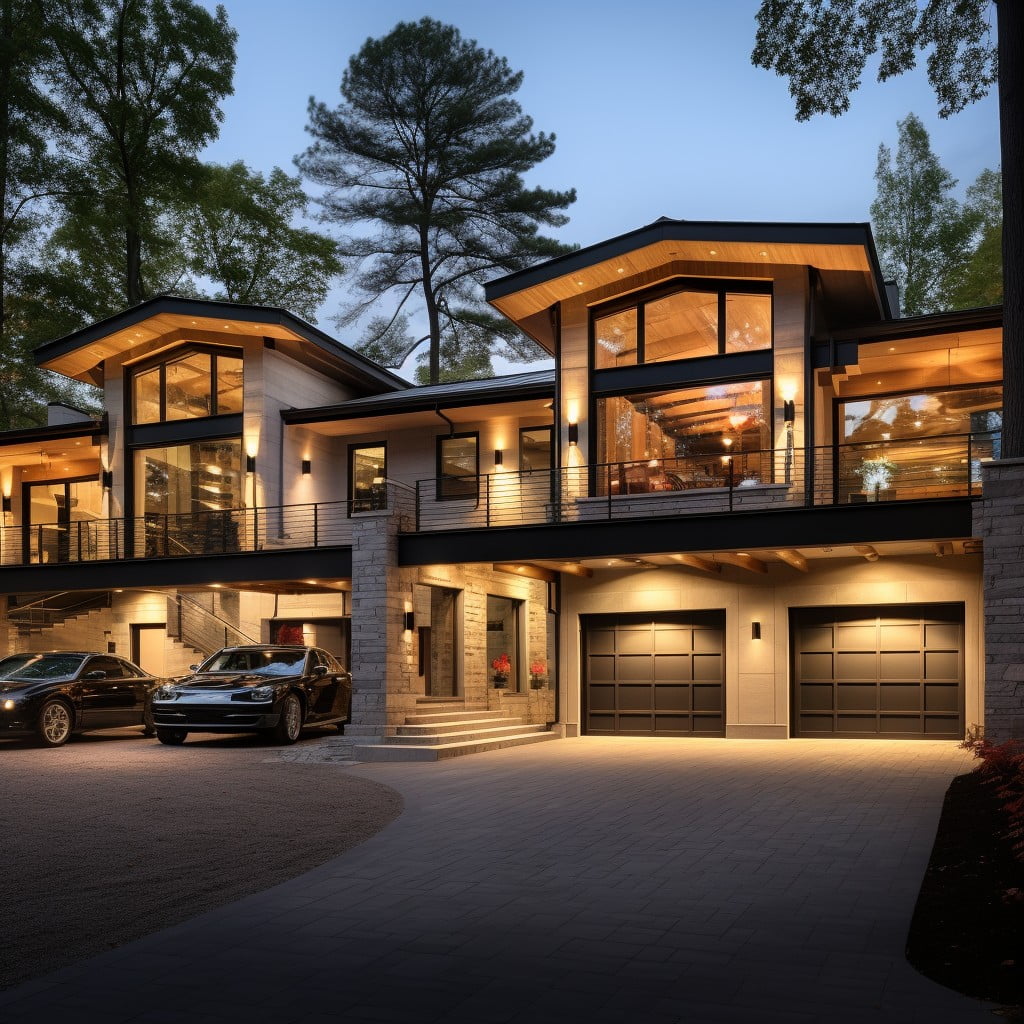Exploring the dimensions and space requirements of a three-car garage can empower homeowners to make informed decisions about their next home improvement project.
A three-car garage typically ranges in size from 600 to 900 square feet, depending on the design and layout. This space allows for the storage of three vehicles, with additional room for storage or workspace.
However, the specific dimensions can vary, with factors such as the size of your vehicles, the need for storage, and the design of your garage playing crucial roles.
Stay with me as we delve deeper into the factors that can influence the size of a three-car garage, and how to make the most of this substantial space.
Key takeaways:
- A three-car garage typically ranges from 600 to 900 square feet.
- Minimum width for a three-car garage is 30 feet, with 20 feet depth.
- An average three-car garage is around 30ft wide by 20ft deep.
- Majority of three-car garages fit within 32 feet width and 24 feet depth.
- Factors influencing garage size: vehicle size, storage needs, property size, budget.
Minimum Three-car Garage Size

Starting with the basics, it’s generally accepted that the minimal width for a three-car garage is 30 feet. This allows for about 10 feet per vehicle, giving enough room for drivers to enter and exit their cars without squeezing against the walls.
As for the depth, the accepted minimum is about 20 feet, allowing enough space for the majority of cars to comfortably fit. However, it’s worth noting that SUVs and trucks may require more depth to properly accommodate their larger size.
Average Size of a Three-car Garage

Typically, the standard measurement falls around 30ft wide by 20ft deep. This affords each vehicle a parking space of approximately 10ft wide, ensuring sufficient room for drivers and passengers to exit the car without hindrance. Also, it provides ample space for opening car doors without the risk of denting or scratching neighboring vehicles.
Although this is the average, the depth can extend up to 22-24ft for larger vehicles or additional storage. Remember, the objective here is to maintain practicality and efficiency within your garage space, ensuring each car has sufficient space, and allowing for smoother navigation and parking.
However, the actual size could vary depending on several factors such as the size of your cars, personal requirements for storage, and architectural constraints.
Three-car Garage Dimensions

A majority of three-car garages will be designed to fit within the dimensions of 32 feet in width and 24 feet in depth.
To accommodate three individual vehicles, each parking spot should measure at least 10 feet wide by 20 feet long.
This allocation allows for sufficient space to open car doors, maneuver around, and even store a few items at the rear of the car.
However, for those seeking additional storage or workspace, extending the depth to 30 feet can create a sizable amount of surplus area.
If you regularly work on larger vehicles such as trucks or SUVs, or if your family owns larger vehicles, you might consider wider spaces, perhaps 12 feet per each car.
Remember, these dimensions offer only a basic starting point; customizing to match your specific vehicles and storage needs may warrant adjusting these numbers.
Factors Influencing the Size of a Three-car Garage

Several considerations come into play when determining the appropriate dimensions for a three-car garage. The type and number of vehicles you own form a major criterion. Larger vehicles such as trucks and SUVs require more space than standard cars. If you own a boat or intend to use the space for storage or as a workshop, you’ll need extra room since these items take up additional square footage.
The architectural style and size of your property is another crucial factor. Your goal is often to strike a balance, ensuring the garage complements the home’s aesthetics without overwhelming the landscape or infringing on other outdoor spaces.
Some homeowners also need to adhere to local zoning regulations which may restrict the size and location of garages. This could influence not only the overall size but also the design to optimize the available space. Lastly, your budget plays a role. Larger garages need more materials and labor for construction, increasing the overall cost.
Functional Design Aspects of a Three-car Garage
When considering functionality, three critical elements come into play: layout, garage door positioning, and storage or work areas.
Firstly, the layout choices are either a long, single row where all the vehicles park in a line, or a double-deep design where two cars park one behind the other with the third separately. Your choice will largely depend on the available space and personal preferences.
Garage door positioning is another crucial aspect. You can opt for one large door or multiple smaller doors. While one large door may cost less, three doors offer convenience, especially when cars are parked in a line.
Lastly, do think about the need for additional storage or work areas. A 30×30 feet garage size, for instance, would provide ample room for three vehicles while allowing for a small workshop or storage area. Even in smaller sizes, smart storage solutions can free up significant space.
Remember, a well-designed garage can not only fit your cars comfortably but also cater to your storage needs and hobbies.
Variations in Three-car Garage Sizes
A one-size-fits-all model doesn’t apply when it comes to three-car garages, as varying sizes accommodate different needs and preferences. A significant criterion that impacts size includes the type of vehicles to be stored. For example, compact cars, SUVs, trucks, and recreational vehicles each demand different spaces.
Building regulations also introduce variations. Each city may have its own code requirements regarding garage size, thereby influencing final dimensions. Homeowners may also prefer custom sizes depending on their property size and usage plan; for instance, incorporating workspace or storage can augment the garage size.
Lastly, architectural style and aesthetics contribute to size variations. Some may opt for wider or deeper garages to match their house’s design ethos. Therefore, while the standard guidelines provide a basic understanding, actual three-car garage sizes may differ, blending functionality with individual desires.
Choosing the Best Three-car Garage Size for Your Needs
Understanding your specific needs is the key to determining the perfect garage size. Consider the following points to help make an informed decision:
1. Vehicle size: Bigger vehicles like SUVs and trucks will require more space compared to compact cars, impacting the width and length of your garage.
2. Storage Needs: If you intend to use the garage for storage, you will need to accommodate additional space. Measure your storage items and include this in your space planning.
3. Workspace: Users requiring a workbench or hobby space within their garage should factor this into their layout.
4. Future-proofing: Consider future needs such as bigger cars, additional storage or workspace which might require additional space.
5. Property Size: Ensure that your property can accommodate your ideal garage size. Laws and regulations could also restrict how big you can build your garage.
6. Budget: Larger garages cost more. Make sure your dream garage aligns with your financial constraints to avoid overspending.
By giving thought to these factors, you’ll be better equipped to pinpoint the optimal size for your three-car garage.
FAQ
What is the average size of a 3 car garage?
The average size of a three-car garage is typically 32 feet wide and 22 feet deep; however, a more preferable dimension is 36 feet wide and 24 feet deep for supplementary truck or storage space.
How many cars fit in a 30×30 garage?
A 30×30 garage can comfortably accommodate two cars side by side with some room to spare.
How many cars fit in a 30×40 garage?
A standard 30×40 garage can comfortably accommodate three cars, but with an additional overhead door, it could potentially house up to six cars or four full-sized trucks.
Is 30 ft wide enough for 3 car garage?
Yes, a 30-foot width is sufficient for a 3-car garage according to most standards.
What are the standard dimensions for each car space in a 3-car garage?
The standard dimensions for each car space in a 3-car garage are typically 9 to 10 feet wide and 20 feet long.
Can a 3-car garage accommodate larger vehicles such as SUVs and pickup trucks?
Yes, a 3-car garage can comfortably accommodate larger vehicles like SUVs and pickup trucks.
How much extra space should you plan for in a 3-car garage for storage or work areas?
For adequate storage or work areas in a 3-car garage, planning for an additional 100 to 150 square feet of space is recommended.